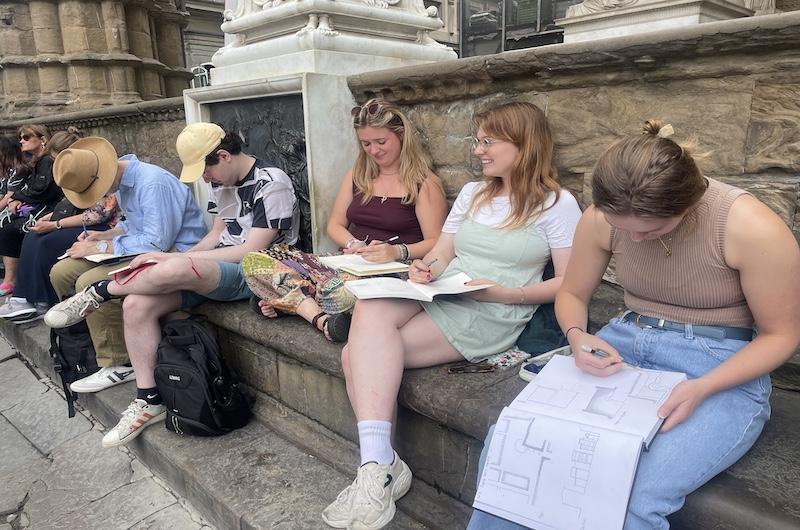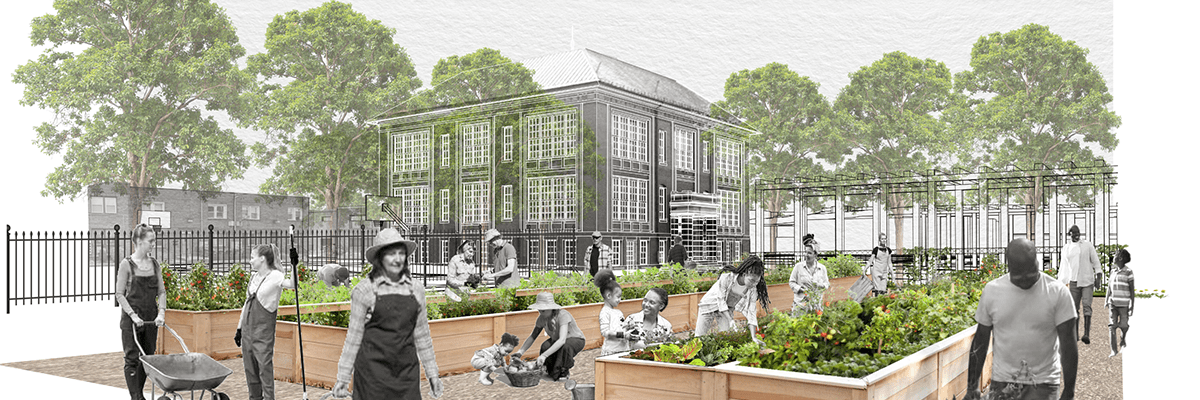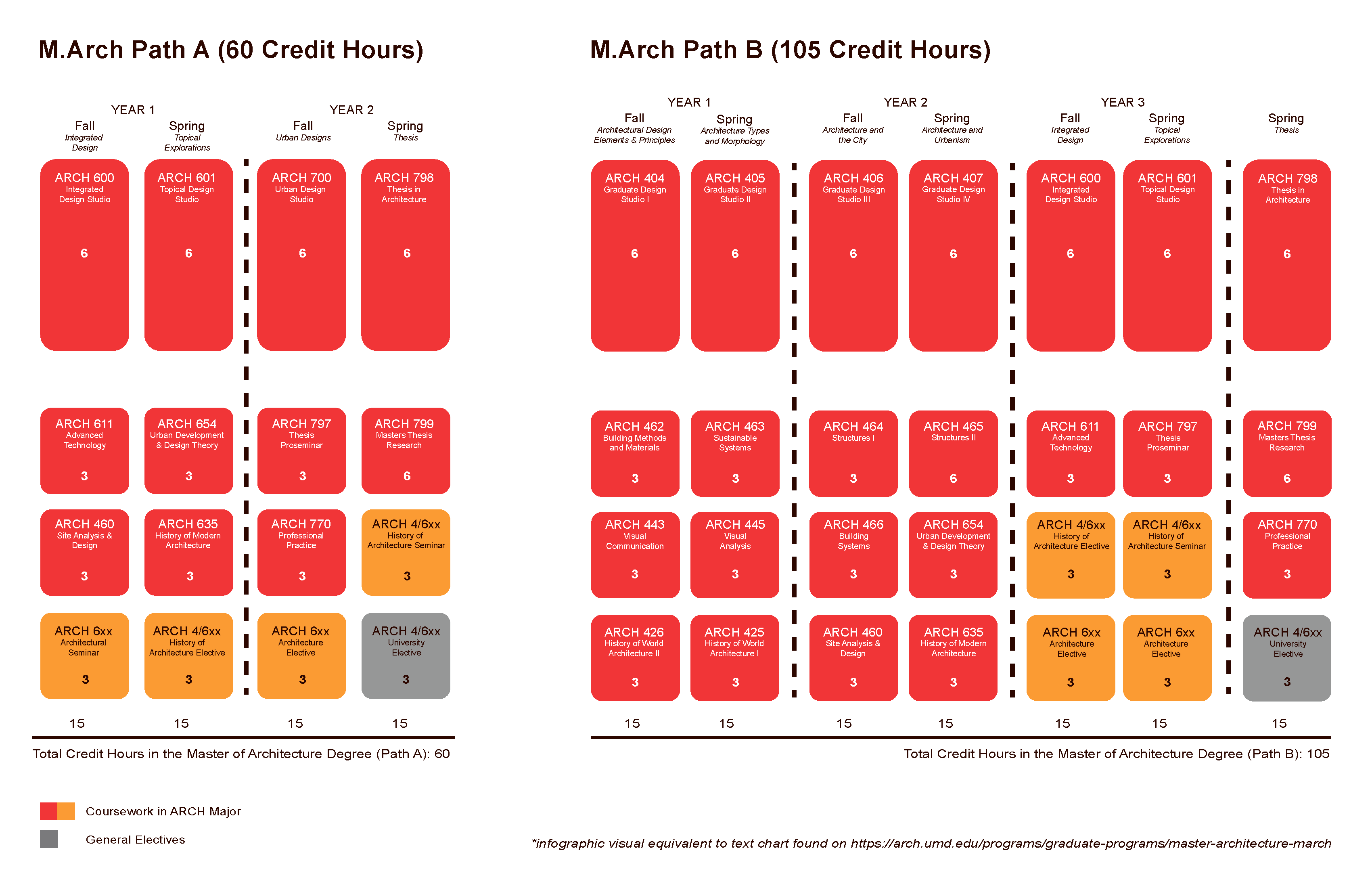Architecture at UMD
Earn a Nationally Recognized Education
Our NAAB-accredited, professional architecture degree that prepares you to tackle the defining challenges of our time through critical inquiry, collaboration and socially and environmentally minded practice.
Learn from Practicing Architects
Work side-by-side with practicing architects, scholars, and professional mentors while building your expertise in design fundamentals, history, urbanism, and sustainable building technologies.
The World is Your Classroom
Explore the culturally and architecturally rich Washington, D.C. region or engage in one of our many education abroad trips, global classroom collaborations and international competitions.
Master of Architecture
The University of Maryland’s Master of Architecture (M. Arch) is a STEM-designated, NAAB-accredited professional degree, essential for pursuing licensure as an architect in North America. Anchored by an experiential and design-focused curriculum, interdisciplinary collaboration and professional mentorship, our master’s degree offers a comprehensive, career-ready experience within a supportive, tight-knit community.
The Master of Architecture Program offers two paths to the profession:
PATH A
For candidates with a Bachelor of Science in Architecture, this four-semester program offers advanced standing toward the M. Arch degree.
PATH B
Designed for individuals with a Bachelor of Arts in Architecture or a non-architecture undergraduate degree, this seven-semester program covers architectural fundamentals and leads to the M.Arch degree. Applicants with related degrees may receive limited advanced standing based on prior coursework, transcripts and portfolios. This limited advanced standing reduces the number of required credits but does not shorten the overall time to completion.
Curriculum
- To view the degree's most updated curriculum, please visit UMD's Graduate Catalog.
- To view current course offerings, visit Testudo.
M.Arch Sample Curriculum - Path A
| Course Number | Course Title | Type | Credit |
|---|---|---|---|
| YEAR 1 | |||
| SEMESTER 1 | |||
| ARCH 600 | Comprehensive Design Studio | Required | 6 |
| ARCH 611 | Advanced Technology | Required | 3 |
| ARCH 460 | Site Analysis and Design | Required | 3 |
| ARCH 6xx | Architectural Seminar | Elective | 3 |
| Semester Total | 15 | ||
| SEMESTER 2 | |||
| ARCH 601 | Topical Design Studio | Required | 6 |
| ARCH 654 | Urban Development and Design Theory | Required | 3 |
| ARCH 635 | History of Modern Architecture | Required | 3 |
| ARCH 4/6xx | History/Theory of Architecture Elective | Elective | 3 |
| Semester Total | 15 | ||
| YEAR 2 | |||
| SEMESTER 3 | |||
| ARCH 700 | Urban Design Studio | Required | 6 |
| ARCH 797 | Thesis Proseminar | Required | 3 |
| ARCH 770 | Professional Practice | Required | 3 |
| ARCH 6xx | Architecture Elective | Elective | 3 |
| Semester Total | 15 | ||
| SEMESTER 4 | |||
| ARCH 799 | Thesis Research | Required | 6 |
| ARCH 798 | Thesis | Required | 3 |
| ARCH 4/6xx | History/Theory of Architecture Seminar | Elective | 3 |
| XXXX4/6xx | University Elective | Free Elective | 3 |
| Semester Total | 15 | ||
| Total Credit Hours in the Master of Architecture Degree | 60 |
M.Arch Sample Curriculum - Path B
| Course Number | Course Title | Type | Credit |
|---|---|---|---|
| YEAR 1 | |||
| SEMESTER 1 FALL | |||
| ARCH 404 | Graduate Architectural Design Studio I | Required | 6 |
| ARCH 462 | Building Methods and Materials | Required | 3 |
| ARCH 443 | Visual Communication | Required | 3 |
| ARCH 426 | History of World Architecture II | Required | 3 |
| Semester Total | 15 | ||
| SEMESTER 2 SPRING | |||
| ARCH 405 | Graduate Architectural Design Studio II | Required | 6 |
| ARCH 463 | Sustainable Systems | Required | 3 |
| ARCH 445 | Visual Analysis | Required | 3 |
| ARCH 425 | History of World Architecture I | Required | 3 |
| Semester Total | 15 | ||
| YEAR 2 | |||
| SEMESTER 3 Fall | |||
| ARCH 406 | Graduate Architectural Design Studio III | Required | 6 |
| ARCH 464 | Structures I | Required | 3 |
| ARCH 466 | Building Systems | Required | 3 |
| ARCH 460 | Site Analysis and Design | Required | 3 |
| Semester Total | 15 | ||
| SEMESTER 4 SPRING | |||
| ARCH 407 | Graduate Architectural Design Studio IV | Required | 6 |
| ARCH 465 | Structures II | Required | 3 |
| ARCH 654 | Urban Development and Design Theory | Required | 3 |
| ARCH 635 | History of Modern Architecture | Required | 3 |
| Semester Total | 15 | ||
| YEAR 3 | |||
| SEMESTER 5 FALL | |||
| ARCH 600 | Integrated Design Studio | Required | 6 |
| ARCH 611 | Advanced Technology | Required | 3 |
| ARCH 4/6xx | History/Theory of Architecture Elective | Elective | 3 |
| ARCH 6xx | Architectural Elective | Elective | 3 |
| Semester Total | 15 | ||
| SEMESTER 6 SPRING | |||
| ARCH 601 | Topical Design Studio | Required | 6 |
| ARCH 797 | Thesis Proseminar | Required | 3 |
| ARCH 4/6xx | History/Theory of Architecture Seminar | Elective | 3 |
| ARCH 6xx | Architecture Elective | Elective | 3 |
| Semester Total | 15 | ||
| YEAR 3.5 | |||
| SEMESTER 7 FALL | |||
| ARCH 799 | Thesis Research | Required | 6 |
| ARCH 798 | Thesis | Required | 3 |
| ARCH 770 | Professional Practice | Required | 3 |
| XXXX4/6xx | University Elective | Free Elective | 3 |
| Semester Total | 15 | ||
| Total Credit Hours in the Master of Architecture Degree | 105 |
M.Arch Curriculum Graphic
Preparing You for Practice

Education Abroad
Learn about our semester in Florence, Italy and shorter three- and six-week global programs in Cuba, India, Italy, Scandinavia, Japan and more.

Spaces and Studio
Great designs start here! Explore our collaborative studio, fabrication lab and MAPP’s makerspaces.

Professional Mentorship
From experience to support, learn how our network of practitioners will help you get a foothold in the design industry.
Admissions
Admission is competitive and varies by program. Applicants should have a solid academic background with at least a bachelor's degree from a regionally accredited institution or equivalent. A minimum 3.0 GPA is required. Apply during or after your final undergraduate year, but provide proof of graduation by your first term's end. The admissions committee evaluates all applicants based on coursework, transcripts, and portfolio review.
Prerequisites
Admission Prerequisites, Path A
For candidates with a Bachelor of Science in Architecture. Required coursework includes:
- 4 - Architectural Design Studios (6 credits each)
- 2 - Structural Systems Courses (3 credits each)
- 2 - History of World Architecture Courses (3 credits each)
- 1 - Building Materials and Assemblies Course (3 credits each)
- 1 - Environmental Systems Course (3 credits each)
Admission Prerequisites, Path B:
For candidates with a Bachelor of Arts in Architecture or a non-architecture undergraduate degree. Required coursework includes:
- One semester of college-level calculus, or successful high-school advanced-placement (AP) calculus exam
- One semester of college-level laboratory physics or successful high-school advanced-placement (AP) physics exam
- Recommended: one college-level course in freehand drawing
Prerequisites must be completed by the time of matriculation to the University of Maryland.
Applicants who have not yet completed the prerequisites should describe their plans to complete them in their Statement of Goals in the application.
Application Requirements
Apply for the Master of Architecture program through the graduate application website. Use the code "ARCH" when prompted.
Application Fee:
- A non-refundable $80 fee per program is required, payable online for submission.
- To find out if you are eligible for an application fee waiver, please visit the Graduate School website.
Transcripts:
- Unofficial transcripts from all institutions, including University of Maryland. Official transcripts must be sent directly if admitted.
Letters of Recommendation:
- Three recommendations online, assessing your potential for success in the program.
Statement of Purpose:
- A 1000-2000 word statement detailing your goals for graduate study
Personal Experience Statements:
- At least one of three statements about their personal experiences relative to the topics below:
- Community involvement and/or service
- Engagement in leadership roles, facilitating change, and/or mentoring
- Overcoming social, economic, educational, or physical barriers
Resume:
- An up-to-date resume
Portfolio:
For portfolio requirements, please visit the Graduate School portfolio requirements page.
Verification of Prior Education
Candidates who completed a Bachelor of Science in Architecture degree at a university other than UMD, or an architecture-related degree program, undergo a review of their transcripts, syllabi of previous courses and portfolio to determine their M.Arch course plan. Prospective students come from different types of programs and have different needs, aptitudes, and knowledge bases. For instance, some prospective PATH A students may need to take additional courses beyond the typical 60-credit hour curriculum based on their prior education, while some prospective PATH B students may be allowed to waive some courses in the 105-credit hour curriculum based on their prior education.
The Architecture Program has a thorough and equitable process for evaluating a student’s prior academic coursework related to satisfying NAAB accreditation criteria:
Steps to Verify Preparatory Education:
- During the application process, eligible applicants will be sent a Verification of Preparatory Education (VPE) form. The form must be completed by the applicant, and the student must submit the syllabus for each course he or she is requesting be waived.
- Once the VPE has been assessed by the Chair of the Admissions Committee, a course plan that indicates the courses and credit hours required to complete the degree program will be developed and issued to each applicant at least 2 weeks prior to the deadline to accept or decline the offer to enroll.
Detailed Evaluation Criteria:
- Studio Placement: Based on portfolio evidence of architectural design proficiency in academic settings.
- History Courses: Equivalent to two semesters of world architecture history, or multiple courses covering broad cultural and geographical contexts.
- Technology Courses: Equivalency assessment of five essential undergraduate courses in architectural technologies.
- Non-Waivable Courses: Includes foundational courses such as Integrated Design Studio and Advanced Technology Seminar.
International Applicants
Applicants who are not U.S. citizens or permanent residents must submit additional documents. Updated information is available on the Graduate School International Admissions web page. Please make sure to follow all the steps specified on the Graduate School International Admissions Page.
Deadline
The deadline for Fall 2026 applications to the Master of Architecture is January 16, 2026 (domestic and international applicants).
Technology Requirements
Tuition and Fees
Below is an initial estimate for all tuition, fees, books, general supplies, and specialized materials that may be required during the full course of study for completing the PATH A and PATH B programs:
PATH A (60 credit hours)
Tuition and Fees: please visit the Student Financial Services and Cashiering website for cost per credit hours
Books, General Supplies, and Specialized Materials: $3,648.61
PATH B (105 credit hours)
Tuition and Fees: please visit the Student Financial Services and Cashiering website for cost per credit hours
Books, General Supplies, and Specialized Materials: $5,729.27
Apply
Apply through the graduate application website. Use application code ARCH.


